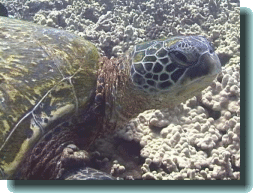
| 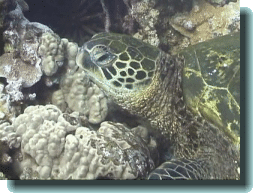
|
Nui 2000 60K JPEG | Tutu 2000 48K JPEG |
Last summer we delighted in a new Honokowai record. We had identified 141 Hawaiian green turtles (honu), our best season ever. Well, Summer 2000 promises to break this old record and head into new ground.
At the end of only our third week of diving, we've already sighted a total of 127 honu. Just over 55% of them are resights.
This week was a good one for seeing some old friends again. Both Tutu and Nui are here this summer. Both appear to be staying on the homefront this nesting season. We've known both these turtles since 1990--at least a decade's residency at Honokowai.
The honu that holds the residency record--here since 1989--is presently missing, however. We believe Kaula, a male, might be doing a tour of duty at the honu nesting site at French Frigate Shoals.
Another prominent Honokowai resident who's presently unaccounted for is Zaphod. We've known this honu since 1992 and she's been almost a daily presence since that year. So far? Just not around. We've felt Zaphod is a female for about two years now. Perhaps this is her first call to nest. We're thinking anxiously about her too.
We worry about Kaula and Zaphod being away from their home because we know the open ocean is a dangerous gauntlet they must navigate.
Friends missing... but another has answered roll call. This week we sighted Limu, a youngster in 1995, for the first time for 2000. She was resting under Mt. Balazs, a prominent coral outcropping, with another old friend from the same year, Tamu.
Limu had early eye tumors in 1995 and her condition worsened until last summer, when her tumors seemed stable. Certainly Limu has grown in size and girth and she seems to be doing well. We hope to add her to our list of regression cases by 2001. We're keeping our fingers crossed...
It was a strange, strange week underwater. The full moon was working its wonders on the shelled wonders out here--weird, weird week. Lots of conflict and getting in each other's faces.
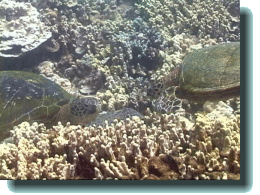 67K JPEG | 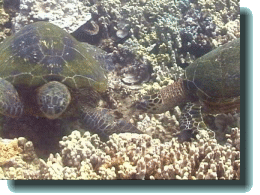 62K JPEG | 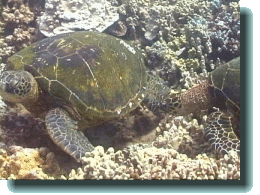 63K JPEG |
Keoki, our resident hawksbill, charged a honu | ||
A honu bullied our unattended underwater camera... 49K JPEG | 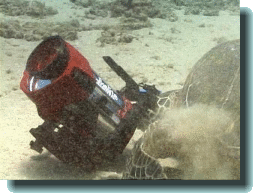
|
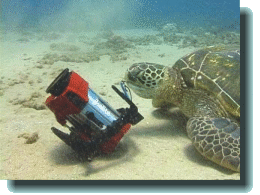
| ...then tried to EAT it! 51K JPEG |
One honu buzzed Ursula--three times! On the same dive! 65K JPEG | 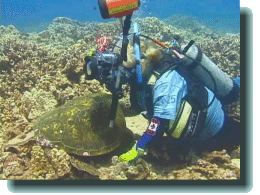
|
This week we've been gathering samples of Lyngbya majuscula--not a particularly pleasant activity. This dark brown hair-like seaweed is easy to collect, but not so easy to preserve!
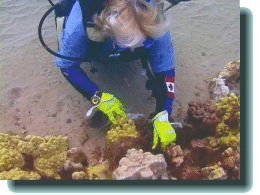
| Easy to collect, but not so easy to preserve! 50K JPEG |
We've also been monitoring the abundance of a sea hare, scientific name Stylocheilus striatus. We will eventually collect several specimens of these as well. We've been told the most humane way to kill them is to put them in the freezer. Still will be tough to do.
Perhaps it's because we're Canadian and know the freezing-depths of February first hand. We loathe the cold so we'll be saddened to condemn these creatures to the bottom rack of our freezer.
Does the Lyngbya here contain toxins? And do the sea hares, by feeding on the Lyngbya, acquire the toxins? We hope to find out.
We'd just prefer none of the sea hares would have to be killed. We've grown rather fond of all twelve zillion of them.
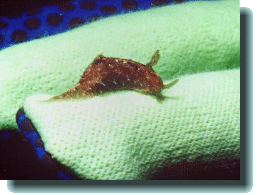
| We've grown rather fond of all twelve zillion of them 44K JPEG |
 Who's Who Underwater at Honokowai
Who's Who Underwater at Honokowai